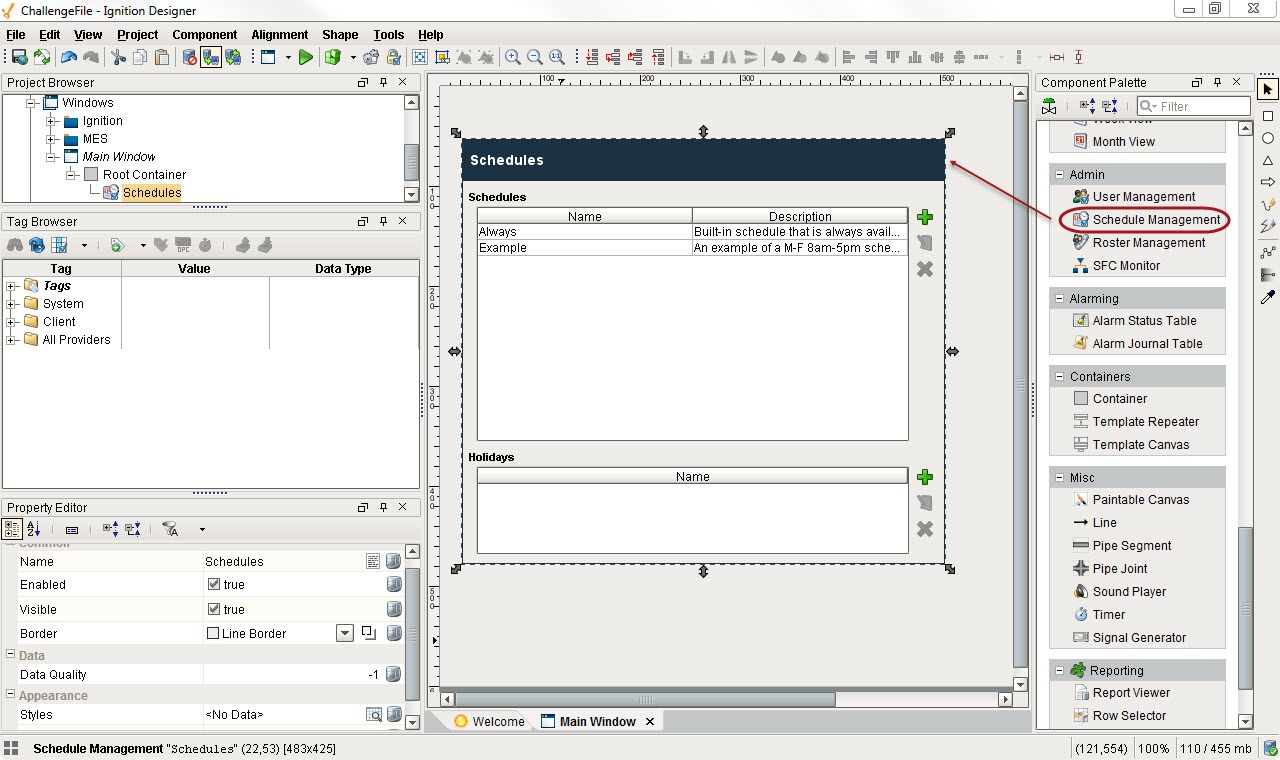User Schedules
Schedules
Schedules define the times of users on-call availability and unavailability. For example, the Always schedule is a schedule that is active 24/7. You can set a schedule for each user in the alarm notification system. The notification messages are then sent only to those users with an active schedule. When a message reaches a notification block in a pipeline, that block's on-call roster is used to find the users with active schedules so they can be notified.
There are also a number of system functions that allow you to create, read, edit, and delete schedules or holidays from a user source using scripting. (i.e., system.user.addSchedule, system.user.getHoliday, etc.,). To learn what system functions are available for user scheduling and holiday scripting, refer to the Scripting Functions in the Appendix.
To Define a New Schedule
- Go to the Configure section of the Gateway.
- Choose Alarming > Schedules from the menu on the left.
- The Schedule Management page is displayed. Here, you can see any Always and an Example schedule.
- The Always Schedule is a built-in schedule that is always available (24x7x365).
- The Example Schedule is an example of a Monday-Friday 8am-5pm schedule with a lunch break. Click on the edit to see the detailed settings.
- The Schedule Management page is displayed. Here, you can see any Always and an Example schedule.
- Click on Create new Schedule.
- Choose a Standard or Composite schedule and click Next.
- The Standard schedule is defined by hours of operation on each day, with repeating options.
- The Composite schedule is defined by the combining of two other schedules.
- On the New Schedule page, enter a Name, the Schedule to be notified, and any Repeating options, then click Add Schedule.
- Each schedule is defined by which days of the week it is active for, and during what times.
- You can define repeating patterns that repeat either weekly or daily, and even plug in holidays.
- When defining time ranges, use a 24-hour format and commas to break up different spans. For example, if you want the schedule to be active from 8am-5pm with a 45 minute break starting at noon, you'd use: 8:00-12:00, 12:45-17:00.
Managing User Schedules from the Client
There are a few ways to manage user schedules from the Client. The first is to use the Schedule Management component on a window. This component allows you to quickly and easily manage the schedules from the Client.

For more granular control, you may instead want to use scripting to manage the schedules. This may offer a more granular control at the click of a button.
# This code creates a new schedule by using an old schedule but setting observe holidays to true.
mySchedule = system.user.getSchedule("WeeklySchedule")
if mySchedule != None and mySchedule.getType() == "basic schedule":
mySchedule.setObserveHolidays(True)
mySchedule.setName("NewWeeklySchedule")
system.user.addSchedule(mySchedule)
Using Schedules for Alarm Notification
The alarm notification system always uses the Schedules. When an alarm notification pipeline reaches a notification block, it looks at all of the users defined in that block's configured on-call roster. Only those users whose schedules are currently active will be notified. This way, you can group people in call rosters by role, not by shift. For example, suppose you have alarms that should be sent to all supervisors. You can put all of the supervisors in one call roster, and the scheduling system will automatically only notify those supervisors who are on-shift when the alarm goes active.
Using Schedules for Restricting Login
You can use Schedules to restrict users' ability to log in. To enable this, select the Schedule Restricted option on the user source in question. That user source will then reject logins for users whose schedule is inactive, even if their credentials were accurate.
